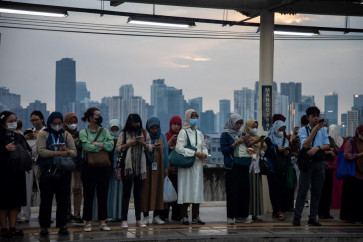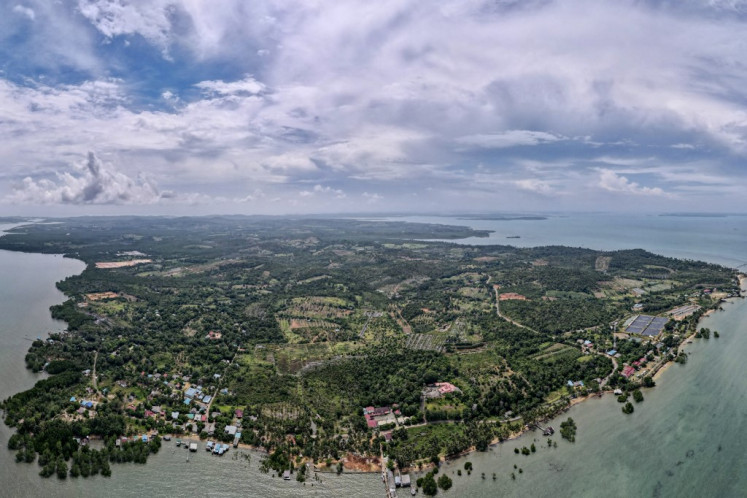Popular Reads
Top Results
Can't find what you're looking for?
View all search resultsPopular Reads
Top Results
Can't find what you're looking for?
View all search resultsTeenagers take on 'Toga' tradition
TOGA DANCE: The Toga dance is performed in the yard of the ancient Siguntur Kingdom in Dharmasraya in West Sumatra
Change text size
Gift Premium Articles
to Anyone
TOGA DANCE: The Toga dance is performed in the yard of the ancient Siguntur Kingdom in Dharmasraya in West Sumatra. (JP/Syofiardi Bachyul Jb)
It was almost dusk in the subdistrict of Siguntur, on the banks of Sumatra.
In the gardens of the Siguntur Palace, a traditional Minangkabau building with pointed roofs, the king sat on his throne. He gazed straight ahead with authority, a staff in his right hand.
The king was flanked by two warriors dressed in red, wielding old, long swords that had long since lost their luster.
Four women readied their traditional musical instruments. One of them stood between two big hanging gongs, in each fist a baton so she could strike them in turn.
The other three each sat behind smaller gongs that were arranged in different notes.
Four young female dancers entered, each with a thin red stole in her hand, forming two lines facing the king. Eight traditional singers, men and women, followed on both sides of the dancers.
(JP/Syofiardi Bachyul Jb)
As the music began to play, the dancers and singers moved into action. They chanted verses in the Minang tongue with its typical Siguntur dialect, telling the same stories in an interesting way.
The dancers waved their shawls, turning to the left and to the right, and whirling around now and again.
Some minutes before the end of the 25-minute show, a man dressed in black like a Minang martial arts practitioner appeared before the king, knees bent, begging for mercy. The king granted him forgiveness.
And thus the performance, called Tari Toga, an ancient dance of the Siguntur Kingdom, was over. All the performers, still in their teens, left the arena to change out of their costumes.
Princess and heiress to the Siguntur Kingdom, Marhasnida, who initiated the recovery of the ancient Toga dance in the 1980s, plays a musical instrument to accompany the dancers. (JP/Syofiardi Bachyul Jb)
Taken to mean tari larangan (sacred dance), Tari Toga is related to the Minangkabau Kingdom in Pagaruyung and also the Malay Dharmasraya Kingdom during the Hindu-Buddha era. Therefore, some of its movements resemble Minang and Malay dances.
According to Siguntur heirs, the Toga dance was an official royal dance dating back to the Dharmasraya kingdom, which was based in the Siguntur area in the 14th century.
It continued to appear when the Hindu-Buddha kingdom converted to Islam, partly splitting into the Siguntur kingdom in 1673. Its first Islamic king was Sutan Abdul Jalil Sutan Syah Tuanku Bagindo Ratu.
At that time, the Toga dance was performed during coronation ceremonies called batagak, royal weddings, initiation ceremonies for the king's children, war victory celebrations and contests for the future spouses of princesses.
When Dutch troops invaded Siguntur in 1908, the royalty of Siguntur and surrounding kingdoms were forced to recognize the Dutch colonial government, thus losing their sovereignty.
Various royal heirlooms including tambo (historical records) were seized and art performances discontinued.
"The Toga dance was almost lost after a long absence and has only been handed down by word of mouth through generations. I gathered all such information and revived the dance in 1989," Marhasnida, a princess and heiress to the Siguntur kingdom, told The Jakarta Post recently. She is the younger cousin of the present king, Sultan Hendri Tuanku Bagindo Ratu.
(JP/Syofiardi Bachyul Jb)
When Marhasnida initiated the recovery in the 1980s, most Toga dancers and singers had died. Fortunately, a former Toga singer, now in his 80s, was still alive and could still recite the verses. With no more Toga shows, he frequently sang traditional tunes during batobo (gardening or weeding) time along with up to 30 to 60 other villagers to avoid boredom.
"Then a grandmother, with her back slightly hunched, could recall the dance movements. I rearranged the sequences from her memory and trained teenage members of the Siguntur family to perform Toga," said Dharmasraya, a graduate of the Padang Teacher Training Institute (now Padang State University) who teaches arts at the state secondary school of Pulau Punjung.
Marhasnida's modified Toga choreography was performed in different Siguntur royal events, including the ceremony to welcome participants of the Pamalayu Expedition of Marine History organized by the Padang History and Traditional Heritage Center at the end of December.
The verses sung to accompany the dance tell the tale of a kindhearted man named Sutan Elok, who was killed by a buffalo. The owner of the buffalo, Bujang Salamaik, was brought before the king, who ordered that his head be cut off -- a common punishment in the Dharmasraya period.
Learning about the punishment, Cati Bilang Pandai, the king's adviser, represented by the Toga singers, starts chanting to console the sovereign. Cati says, though the buffalo killed the man, its owner should not pay the price. The song touches the king, who spares the life of Salamaik.
"In the past, performers danced and chanted for seven hours, and they were over 40 years old. Now the dance takes less time and I choose young dancers who are quicker to learn," added Marhasnida. In fact, the Bujang Salamaik story is only one of many others left for Toga. The rest, including Dendang Ameh, are only known by their titles, as nobody can recall their lyrics.
"Luckily, we managed to record what was left of the Toga dance and Bujang Salamaik, the tale of a man whose life is spared by the king. If we had waited any longer, the dance would have been but a distant memory," she said.













